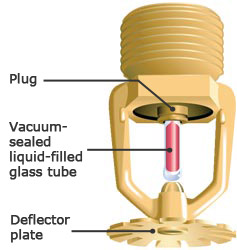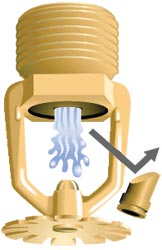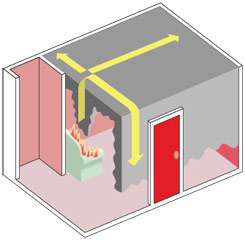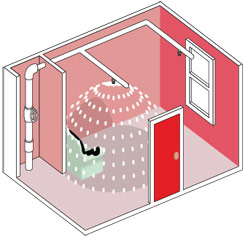Domestic sprinklers
There is clear evidence that sprinklers can be effective in stopping fires spreading, significantly enhancing fire safety within the home and drastically reducing death and serious injury as a result of fire.
There is clear evidence that sprinklers can be effective in stopping fires spreading, significantly enhancing fire safety within the home and drastically reducing death and serious injury as a result of fire.
Derbyshire Fire & Authority plays a key leadership role in promoting a better understanding of the benefits of sprinklers as part of a core commitment to reducing the impact of fire on people, property and the environment in Derbyshire.
Sprinklers have been successfully used for the protection of property such as factories, department stores and shopping centres for well over 130 years and there is now a growing appreciation of their potential to save lives in domestic properties where the majority of deaths from fire occur.
A smoke alarm alerts you of a fire, but a sprinkler system will control or extinguish the fire.
Smoke detectors are a super alert system and warn you there is a fire, but a sprinkler system will extinguish the fire, protecting the occupants and preventing further fire damage that can leave a property inhabitable.
Derbyshire Fire & Rescue Service is working hard to raise the profile and benefits of domestic sprinklers for all new build properties and as a retrofit. Fires in the home still account for the greatest number of fire deaths and injuries each year, having a devastating effect on families and friends and leaving communities in mourning.
The Service has worked closely with key national and local partner organisations and local authorities within Derbyshire to achieve this aim.
Sprinklers can provide the ultimate protection to human life, property and the environment, virtually eliminating fire deaths, reducing injuries by at least 80%, reducing property damage by 90% and substantially reducing damage to the environment from fire. Domestic sprinklers will not only warn of a fire but also act immediately to control it, even when no one is present.
The Think Sprinkler campaign has a number of objectives:
View or download the Think Sprinkler Booklet which you can read or pass onto others and spread the word about the benefits of domestic sprinklers.
Think sprinkler booklet pdf 1,421.26 KB
Installing a sprinkler system is like having a firefighter in every room of your home!
Fire sprinklers are widely recognised as the single most effective method for fighting the spread of fires in their early stages
More than 70 million sprinkler heads are installed worldwide each year
Sprinklers protect the lives of firefighters and are fully supported by fire services
Sprinklers reduce injuries by at least 80%, reduce property damage by 90% and substantially reduce damage to the environment from fire
Sprinklers offer builders more freedom designs and encourage innovative, inclusive and sustainable architecture
Source: https://www.bafsa.org.uk/sprinkler-systems/sprinkler-facts/
Sprinklers detect a fire in the early stages of development and will operate before the fire enrages and becomes life-threatening. The system is heat-activated at a temperate of 57 degrees Celsius (domestic property) when the concealed lid drops off. At 65 - 70 degrees Celsius, the glass bulb of the sprinkler head smashes, allowing the plug to drop and water to be released. Water from the activated sprinkler will cool the atmosphere around the fire, which will reduce the rate of burning, the production of smoke and will protect the surrounding materials limiting fire spread.
Research illustrates that the vast majority of fires controlled by a sprinkler system have involved just one sprinkler head activating.
The following information and original artwork were kindly provided by the Residential Sprinklers Association (RSA). You can find more information about the RSA, residential sprinklers and accredited installers by visiting www.firesprinklers.org.uk.

The typical sprinkler head consists of a plug held in place by a trigger mechanism. The most common type of trigger is a glass ampule filled with a glycerin-based liquid that expands when heated.

This liquid is designed to expand and break the tube at a certain temperature. The most common are designed to break at 65 - 70 degrees Celsius. In the average sized room, a 5mm diameter ampule will usually break in about one to one and a half minutes from contact with a heat source. Ampules as thin as 1mm are manufactured for a faster response time.

The plug is forced out by the pressurized water behind it and deflected away by a bevelled edge. The water sprays over the deflector plate which is designed to distribute it in an even pattern. Water will continue to flow until the main valve is shut off.
Smoke and toxic gases rise from the source of the fire. They spread quickly along the ceiling and heat the air in the room.

The current of hot air forces a curtain of deadly gases down the walls, making escape more difficult. In a few minutes the air will become so hot that the entire contents of the room will ignite spontaneously. This is known as flashover and usually occurs between 1,000 and 1,500 degrees.

Even a small smouldering fire acts like a heat engine as it steadily increases the air temperature directly above it. The hot air fans out across the ceiling, heating up the nearest sprinkler head.

As soon as the trigger mechanism is heated to the required temperature, it trips and the water is released. The immediate cooling of the heat source usually prevents other sprinkler heads from activating. Often, one or two sprinkler heads are enough to control a fire.

The dramatic effect that sprinkler systems can have on a domestic fire is best highlighted by seeing the difference that sprinklers make to real fires in comparable properties.
The video below outlines the case for domestic sprinklers and contains footage from the controlled demonstration carried out the old Chesterfield Fire Station on the 12th of January 2012.
Footage courtesy of BBC East Midlands.
The video below is the BBC report that covers the successful activation of a portable misting system installed in the home of a vulnerable Derbyshire resident as part of the continuing efforts of the Think Sprinkler campaign to protect those most at the risk of fire in their home.
The incident occurred on the 11th of January 2013 and when firefighters arrived they confirmed that the portable misting system had activated and extinguished the fire. The portable misting system was fitted after a Home Fire Safety Check (HFSC) was carried out by a Community Fire Safety Officer. As a result of the HFSC, there was a recommendation that a portable misting system be fitted to help safeguard the occupant.
Working in close partnership with the family of the occupant, Derbyshire Fire & Rescue Service, with joint funding provided by Derbyshire County Council Adult Care, were able to fit the first portable misting system in Derbyshire, into the property.
Footage courtesy of the BBC.
Derbyshire Fire & Rescue Service's Dave Coss appears on BBC Breakfast to explain the effectiveness and importance of Fire Sprinklers in domesticated homes. A demonstration of the sprinklers can also be found later in the broadcast which shows a comparison between the damage caused by fire, and a sprinkler system.
Footage courtesy of the BBC.
There are a number of high-profile national organisations that are actively promoting the installation of sprinkler systems, which are listed below.
The NFCC is committed to reducing the impact of fire on people, property, the environment and the economy. The NFCC Sprinkler workstream is led by our Chief Fire Officer Gavin Tomlinson and is a key influencer and driver in advising Government bodies as to the use and regulation of sprinklers. NFCC Sprinkler Position
The BAFSA primary objectives include providing authoritative information on the benefits of sprinkler systems and how sprinklers can play a significant role in saving life and property from the devastating effects of fire. BAFSA works closely with the government, fire and rescue service, building control officers, insurers, architects and town planners. BAFSA also has links with overseas bodies including the American Fire Sprinkler Association. http://www.bafsa.org.uk
NFSN is a non-profit organisation, founded in 1998 which remains free from commercial interest. It works in partnership with a wide range of local, national and European governments and the fire and construction industries who share the ideals and objectives in making our communities safer from the threat of fire. To find out more please visit http://www.nfsn.uk
The BSA is a newly incorporated coalition working to achieve greater business resilience through enhanced protection against fire. Established in 2010, the BSA encourages greater business resilience by enhancing protection against fire through the increased acceptance and use of fire sprinklers in commercial and industrial premises.
DFRS will work in co-ordination with all national organisations to highlight and promote automatic fire suppression systems and the benefits they possess. Particular attention will be given to the influencing legislative changes that will ensure the installation of domestic sprinkler systems to all new homes.To find out more please visit http://www.business-sprinkler-alliance.org/
The Local Government Association has an all-party working group looking into raising the awareness of sprinklers in domestic and residential premises. NFCC has been, and continues to advise one of the partners to this piece of work. See the LGA website for more information.
The Residential Sprinkler Association is a non-profit organisation which provides support to the Residential sector of the UK Fire Sprinkler Industry. Please visit http://www.firesprinklers.org.uk/